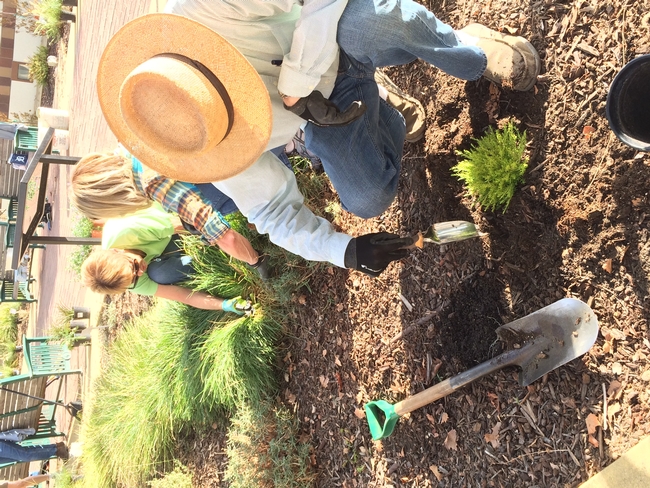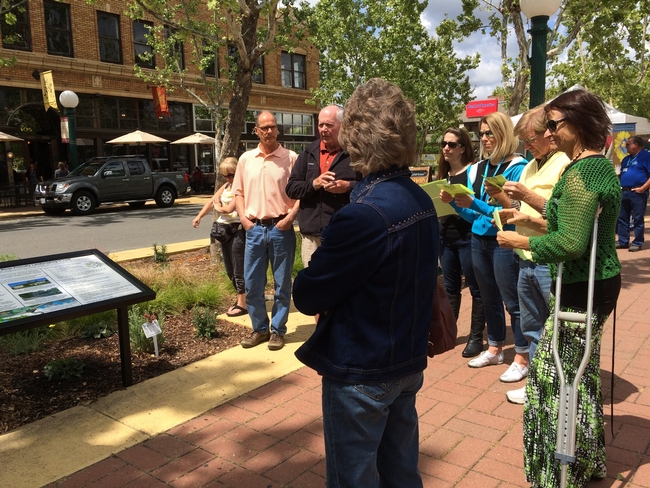An effective UC Master Gardener volunteer should see themselves first as a gardener, then a student, as well as a teacher, a storyteller, and finally, a defender of our shared California waterways and clean air. It may not be obvious, but we all live in a watershed, which is anywhere rain falls and drains, so that whatever pesticide or fertilizer you or your neighbor applies, sprays or pours in their garden, has the potential of drifting in the air, seeping into the soil to contaminate groundwater, or run off in rainwater to pollute nearby creeks and rivers and, of course the Delta. By learning and practicing the Integrated Pest Management (IPM) strategies yourself, you too can become an ambassador by modeling, teaching, and educating your community, and hopefully, improving the water and air quality of your community.
But, what is IPM exactly?
IPM combines multiple strategies to manage long-term prevention of pests in our home gardens, farms, vineyards, orchards, or natural places. Check out the University of California's Quick Tip card, which nicely outlines an overview of IPM. The primary IPM strategies include:
- Prevent pests from invading - A good defense is the best offense. Keep your eyes open for pests in and around your home and garden. Monitor for the presence of pests and their damage. Inspect what comes home from the grocery store. Check pest access to food, water, and shelter around your home and garden, like crumbs, water and weeds.
- Use cultural practices that make an area unfavorable to pests. Clean your home regularly and avoid leaving food sources, like crumbs around, for pests to eat. Store foods in containers with tight-fitting lids. Do not leave weed piles or infested plant material or fallen fruit around for pests to proliferate.
- Control pests with physical methods or mechanical devices. Keep pests out of your home with bug-tight window screens, eliminate cracks of entry doors with weather stripping and caulk. As much as possible, do not plant a garden touching the outside walls of your home. Keep the foundation of your home free of irrigation water reach. Use landscape fabric or mulch for weed control, snap traps to control rats or squirrels, and sticky traps for flies.
- Rely on “good bugs” (natural enemies) to manage pests, especially ants. Biological control is the best first line of defense for handling pest problems. Most gardens contain far more “good bugs,” or beneficial insects, than pest insects. Good bugs like spiders, lady beetles and parasitic wasps feed on pest insects and play an important role in IPM. Help the beneficials by choosing plants that provide pollen and nectar, keeping ants out of pest-infested plants, and avoiding the use of certain pesticides that kill or harm the “good bugs.”
- Use pesticides as a last resort, and always choose the least toxic. Pesticide use should be the last resort. Always read the label and choose the least toxic, effective pesticide that targets your specific pest. Avoid broad-spectrum pesticides that can kill natural enemies as well as pests. Less toxic pesticide choices include horticultural oils, pesticidal soaps, and microbial products such as Baccilus thuringiensis (Bt). Do not choose pesticides that expose you to the pesticide, like bait stations. And always read and follow the pesticide label to protect yourself, others and the environment. Pay attention to the active ingredients. Avoid products containing pyrethroids which have active ingredient names typically ending in “-thrin,” including permethrin, bifenthrin, cyfluthrin, beta-cyfluthrin, cypermethrin, deltamethrin, lambda-cyhalothrin, and tralomethrin, which are toxic in the ecosystem. An exception is esfenvalerate. Pyrethroids have been found in Central Valley watersheds. Cities and counties are mandated to help educate the public on the toxicity of these pesticides in creeks and rivers. Look for “Our Water Our World” labels at some garden stores, which help point out the less toxic pesticides.
- Finally, dispose of pesticides correctly! In San Joaquin County, the best place to dispose of unwanted household hazardous waste, including pesticides, is the San Joaquin County Household Hazardous Waste Consolidation Facility near the Stockton Airport. It has limited days and hours: Thursday through Sunday, 9:00 a.m. to 3:00 p.m. It is closed Easter Sunday, 4th of July, Thanksgiving Day, Christmas Day and New Year's Day. It is located at 7850 R.A. Bridgeford Street, Stockton, CA 95206. For questions or concerns, call Solid Waste Administration at 209-468-3066 during normal business hours.
A Garden Partnership
In conjunction with the Lodi City Council, local business owners and the public, San Joaquin County Master Gardeners have developed a river-friendly demonstration garden in downtown Lodi, on School Street. It showcases the importance of working together as well the principles of a sustainable garden and landscape. The garden area also includes a community-built bench featuring plants and animals of the Mokelumne River watershed. The bench was designed by artist Donna Billick, and the project was overseen by the City of Lodi. Enjoy lunch at a Lodi restaurant and check out the garden.
As Master Gardeners and as an informed public, we can serve as educators in the community. Education is needed now more than ever, as the marketplace is being bombarded with products that are not always the best choice for a safe California or its waterways and air. By taking the time to read and understand the IPM approach, we can help our neighbors, ourselves and our homes, as well as our gardens, to thrive. Please take the time to care and share the IPM way.

